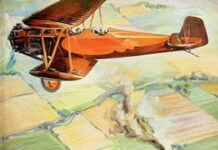Heavier than air flight took off in longer bounds as the 20th century emerged. Progress was all around, and no more so than in the air, as gliders, balloons, blimps, and fixed wing aircraft competed for headlines in the media.
Of course we know, with the wisdom of hindsight airplanes would conquer. But how did this happen? Let us review the major developments together, before the First World War’s all-consuming fury took over the path of development.
Gustave Whitehead: First Claimed Manned, Powered Flight
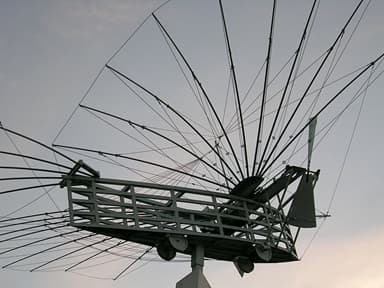
https://commons.wikimedia.org/wiki/File:Leutershausen_Gus_Whitehead_Denkmal.JPG
Gustave Whitehead emigrated from Germany to the United States where he designed and built gliders, flying machines, and engines. He claimed to have successfully flown a powered machine during 1901 and 1902. If this was true, then he predated the Wright Brothers as the first fixed-wing aviator.
An earlier, intriguing incident enlivens Gustave Whitehead’s life. He took up a position as mechanic with the Boston Aeronautical Society promoting innovations. There he and a colleague experimented with gliders and ornithopters. Then in May 1901 Scientific American announced ‘his novel flying machine’ was ready for trials.
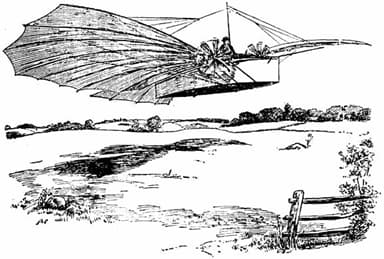
https://en.wikipedia.org/wiki/File:Whitehead_woodcut.jpg
Gustav Whitehead spoke of an earlier test on May 3, 1901 according to Scientific American. During this, he piloted his experimental aircraft at a height of 40 to 50 feet for 659 feet with a 220 pound load of ballast, before crashing into a tree.
On the next occasion, he said he covered a half mile at 659 feet. After that he moved to a secret location to avoid attracting a crowd that might make a ‘snap-shot verdict of failure. However, when his Number 21 aircraft was ready, he invited the media to gather as he maneuvered the aircraft by shifting his body.
Whitehead claimed several more manned flights between 1901 and 1902. There were always witnesses confirming his achievements. However, he fell off the pages of history as the Wright Brothers wrestled the patent rights from Glenn Curtis.
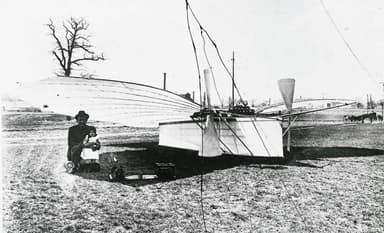
http://www.wright-brothers.org/History_Wing/History_of_the_Airplane/Who_Was_First/Gustav_Whitehead/Gustav_Whitehead.htm
Wilhelm Kress: Manned, Powered Hops From Water (1901)

https://en.wikipedia.org/wiki/File:Wilhelm_Kress_Aeroplane_Wienerwaldsee_1901-10-03.jpg
Wilhelm Kress lived in Bavaria, Germany, where he developed the first modern delta hang glider in 1877. He invented a control stick for an aircraft but did not patent it, leaving an opening for French Robert Esnault-Pelterie who applied for it in 1907
Therefore, Kress is better known for almost taking off from water at the Wienerwaldsee reservoir near Vienna, Austria in his seaplane Drachenflieger, meaning Dragon Flier in 1901.
Emperor Franz Joseph of Austria granted 5,000 Krone towards the project to create the first heavier-than-air flying machine. Kress’s version comprised an open tubular structure with three sets of wire-braced monoplane wings placed in tandem along its length. These were at different heights relative to the aircraft axis to prevent aerodynamic interference between them.
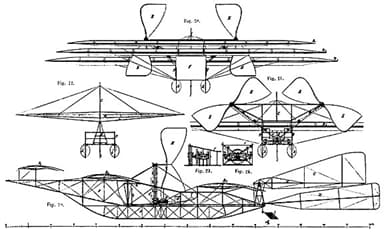
http://www.flyingmachines.org/whkr.html
The Dragon Flyer rested on two, hardened aluminum keels to accommodate take-off and landing from both water and ice.
- Three rudders were linked to a control stick for steering on water and in air
- A Daimler petrol engine drove two large screw-type two-bladed propellers
This was the first recorded occasion on which an internal combustion engine powered a heavier-than-air aircraft. Unfortunately, the project failed to achieve the desired power-to-weight ratio.
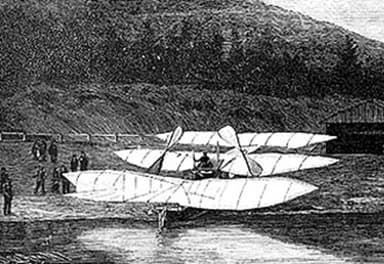
http://www.flyingmachines.org/whkr.html
The Dragon Flyer performed satisfactorily except for the underpowered petrol engine occasioned by cash flow problems. The 1,870-pound aircraft only managed hops along the water. However, taxiing trials were successful, even against headwinds.
Wright Brothers No.3 Glider: Wing Warping for Roll Control (1902)
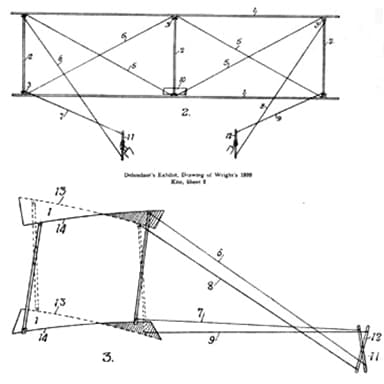
https://en.wikipedia.org/wiki/Wing_warping#/media/File:WrightBrothers1899Kite.jpg
Controlling pitching back-and-forth, yawing side-to-side, and rolling between the wings is the secret of effective flight control. The Wright Brothers distinguished themselves from other aviators by learning to control roll.
Their break-through occurred when they discovered wing warping. Their method comprised a system of pulleys and cables to twist the trailing edges of the wings in opposite directions. Much as kids trim the performance of paper airplanes by curling the paper at the back of the wings.
Their research began in 1899, continued during 1900, and culminated in their No.3 Glider in 1902. This controlled yaw with a rear rudder. The one in the below image is an early double one they converted to a single one later.

https://en.wikipedia.org/wiki/File:1902_Wright_glider_fly.jpg
The Wright Brothers estimated their No.3 Glider made between 700 and 800 glides, although they did not keep accurate records. However, they did record details of the longest flight of 622 feet in 26 seconds. These ideas would culminate in the powered Wright Flyer in 1903 which essentially added the engine.
The Antoinette: First Lightweight Power Plant for Aircraft (1904)
Heavier-than-air flight was being held back by the weight of suitable engines, and the resultant poor power to weight ratio of aircraft. In the summer of 1902, French power plant engineer, aircraft designer, and inventor Léon Levavasseur suggested to industrialist Jules Gastambide they develop a lightweight power plant for the purpose.
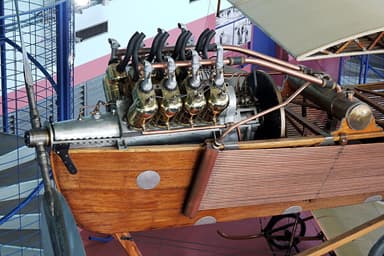
https://en.wikipedia.org/wiki/File:Moteur_de_l_Antoinette_VII_Musee_du_Bourget_P1010360.JPG
The Antoinette engine was technically noteworthy in that:
- It was the world’s first V8 power plant
- It used direct fuel injection and liquid engine cooling
Levavasseur’s Antoinette engines played a significant role in development of lighter-than-air, and heavier-than-air flying machines. Perhaps unintentionally, they also became the power plant of choice for prize-winning speedboats in Europe.
Richard William Pearse’s Reputed Manned, Powered Flight (1903)
Richard William Pearse was a New Zealand farmer and inventor who conducted various pioneering aviation experiments. Many years afterwards, several witnesses came forward claiming he flew, and landed a powered heavier-than-air machine on 31 March 1903, nine months before the Wright brothers achievement.

https://my.christchurchcitylibraries.com/richard-william-pearse/
This recollection inspired patriotic enthusiasm to the point it became a movie. Many grainy images of the aircraft date from that, and not any actual event. Pearse himself said he did not ‘attempt anything practical … until 1904’ in a newspaper interview in 1909. However, our history of flight would be incomplete without mentioning the claim.
Karl Jatho’s Achievement Claiming First Flight (1903)
Karl Jatho was a German inventor and aviation pioneer who claimed a manned powered flight on August 18, 1903. This apparently flew up to 200 feet above the ground in the presence of four people. This ostensibly makes it a contender for the Wright Brothers. But what evidence is there for this?
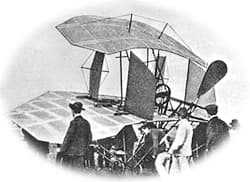
http://www.karl-jatho.com/html/we_were_the_first.html
Karl Jatho made progressively longer hops in a pusher triplane, then a biplane, at Vahrenwalder Heide outside of Hanover. His first flight rose approximately 3 feet over a distance of 60 feet. An article in the Hanover courier a few years later in 1907 states he had been ‘working on controllable air vehicles for 12 years by now’.
Moreover other sources quote Karl Jatho’s notes claiming to have achieved a continuous flight of 200 feet at an altitude of 8 feet. This would have been a month before the Wright Brothers historic achievement.
At that stage the pioneer aviator paused his efforts, noting ‘In spite of many efforts, cannot make longer or higher flights. Motor weak.’ But he was more successful in 1909 with a later machine.
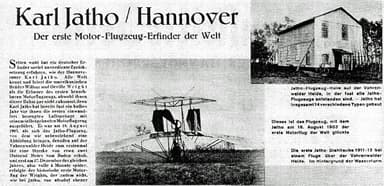
https://commons.wikimedia.org/wiki/File:Hannoverscher_Anzeiger_-_Illustrirte_Zeitung_(Ausschnitt_einer_Seite)_1933-09-17.jpg
The Wright Brothers Make Four Flights (1903)
The Wright Brothers made four flights on December 17, 1903 in their ‘Flyer’ aircraft at Kitty Hawk, North Carolina. Orville Wright made what is generally regarded as the world’s first controlled, powered heavier-than-air flight, traveling 120 feet in twelve seconds.

https://en.wikipedia.org/wiki/File:Wright_First_Flight_1903Dec17_(full_restore_115).jpg
The ‘Flyer’ was made of giant spruce wood to a canard foreplane biplane design, in which the pilot flew lying on his stomach on the lower wing with his head toward the front of the craft, in an effort to reduce drag. He steered by moving a cradle attached to his hips. The cradle pulled wires which warped the wings and turned the rudder simultaneously.
The motor was a scratch-built 12 hp gasoline engine. This used a sprocket chain-drive to turn two propellers rotating in opposite directions to prevent torque effects influencing aircraft handling.
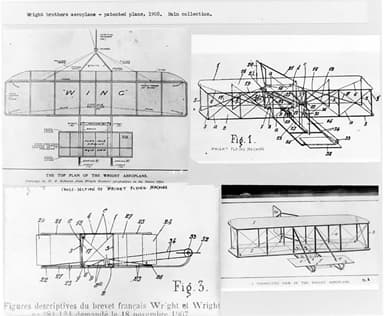
https://en.wikipedia.org/wiki/File:Wright_brothers_patent_plans_1908.jpg
The specification was as follows:
- Length 21 ft, wingspan 40 ft, wing area 510 sq ft,
- Height 9 ft, empty weight 505 lb. max takeoff weight 745 lb
- Max speed 30 mph, service ceiling 30 ft

https://en.wikipedia.org/wiki/File:Wright_Flyer_AN0231034.jpg
The Wright Brothers Patent War: Struggle for Recognition (1905)
The Wright Brothers first attempted to patent their invention in 1905, but failed. They had borrowed ideas from various people, and the question boiled down to what they did differently? Ohio patent attorney Henry Toulmin was more successful. He obtained U.S. Patent 821393 for ‘new and useful Improvements in Flying Machines’ on May 22, 1906.
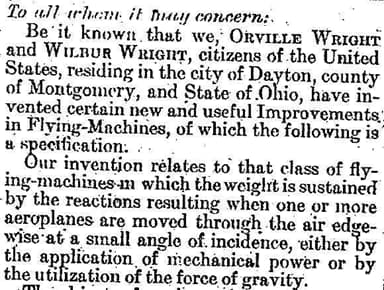
https://en.wikipedia.org/wiki/File:WrightPatentIntro.jpg
The patent application featured their non-powered 1902 glider, and was hence claiming a new and useful method of controlling a flying machine, powered or not. It therefore describes their method of wing warping, and not flying per se.
However, it did allow that other methods could adjust the outer portions of a machine’s wings, to different angles on the right and left sides to achieve lateral (roll) control.
The patent also describes using a steerable rear vertical rudder to enable the airplane to make a coordinated turn, and using a forward elevator for ascending and descending. Various patent wars followed down the years.
Wilbur Wright Makes First Successful Flight in Flyer II (1904)
The Wright Brothers built a modified version of their Flyer in 1904 with a slightly more powerful engine. Significant changes for Flyer II included:
- Using white pine instead of spruce for the frame
- Changing wing camber to 1-in-25 from 1-in-20
- Following this the aircraft weighed 200 pounds more
Orville and Wilbur Wright with Wright Flyer II at Huffman Prairie (May 1904)
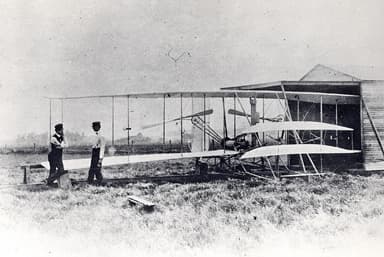
https://en.wikipedia.org/wiki/File:Wright_Flyer_II_shed.jpg
The Wright Brothers began using a launching catapult in September 1904, to avoid repositioning the launch rail thanks to varying winds at Huffman Prairie. This used a falling weight dropping from a 16 foot high derrick, amplified by block and tackle.
This arrangement enabled Wilbur to make a turn in the air on September 15. And a complete circle covering 4,080 feet in one minute 16 seconds on September 20, 1904.
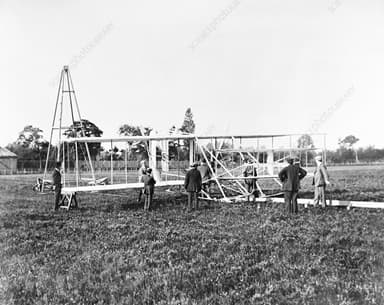
https://www.sciencephoto.com/media/644988/view/wright-flyer-ii-iii-and-catapult-1904-5
Wright Flyer III Takes to the Air on June 23, 1905
Flyer II completed a three-mile flight that lasted longer than 5 minutes at Dayton, Ohio on November 9, 1904. However, the Wright Brothers were far from satisfied and spent the winter of 1904 – 1905 building a successor Flyer III.
They made the frame from spruce wood again, and reverted to a wing camber of 1-in-20. However, they recycled the engine and other hardware from Flyer II. This combination produced their best performance to date.

https://commons.wikimedia.org/wiki/File:1904-10-04_Huffman-Prairie_WrightFlyerIII.jpg
The launch design of Flyer III looked almost identical to the first two versions. But the Wright brothers made several modifications after Orville suffered minor injuries in a serious nose-dive crash on July 14, 1905.
- They doubled the size of the elevator and rudder, and moved them twice as far from the wings
- They fixed two fixed half-moon shaped vertical vanes between the elevators (but removed them later)
- They widened the skid undercarriage. This created a slight dihedral angle between the left and right wings
The Wright brothers also disconnected the rudder from the wing-warping system and added a separate control handle. Finally, they provided for more coolant storage in anticipation of longer flights.
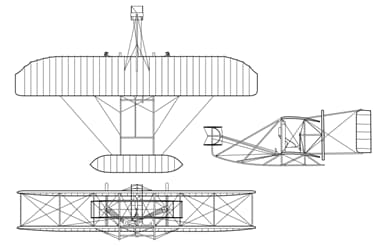
https://commons.wikimedia.org/wiki/File:Wright_Flyer_III_3-view.svg
These alterations turned Flyer III into a practical, dependable aircraft. It could fly for much longer periods, and bring the pilot back to the starting point safely. The brothers won supply contracts from the American and French governments, and fitted their flying machine with two seats.
The age of powered, manned, controlled flight had finally properly begun. The brothers could have had no idea what would follow. Perhaps they did, but alas they did not consider their flying machines particularly historic or worthy of preservation.

https://www.asme.org/about-asme/engineering-history/landmarks/224-wright-flyer-iii





